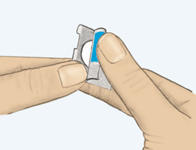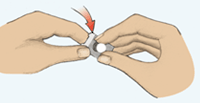SUMMARY CMI
SAPHRIS®
Consumer Medicine Information (CMI) summary
The full CMI on the next page has more details. If you are worried about using this medicine, speak to your doctor or pharmacist.
1. Why am I using SAPHRIS?
SAPHRIS contains the active ingredient asenapine. SAPHRIS is used to treat Schizophrenia and Bipolar 1 Disorder in adults.
For more information, see Section 1. Why am I using SAPHRIS? in the full CMI.
2. What should I know before I use SAPHRIS?
Do not use if you have ever had an allergic reaction to SAPHRIS or any of the ingredients listed at the end of the CMI.
Talk to your doctor if you have any other medical conditions, take any other medicines, or are pregnant or plan to become pregnant or are breastfeeding.
For more information, see Section 2. What should I know before I use SAPHRIS? in the full CMI.
3. What if I am taking other medicines?
Some medicines may interfere with SAPHRIS and affect how it works.
A list of these medicines is in Section 3. What if I am taking other medicines? in the full CMI.
4. How do I use SAPHRIS?
- Your doctor will tell you how many wafers you will need to take each day and how long you need to take it.
- Place the wafer under your tongue and allow to completely dissolve. Do not chew or swallow the wafer.
More instructions can be found in Section 4. How do I use SAPHRIS? in the full CMI.
5. What should I know while using SAPHRIS?
| Things you should do |
|
| Things you should not do |
|
| Driving or using machines |
|
| Drinking alcohol |
|
| Looking after your medicine |
|
For more information, see Section 5. What should I know while using SAPHRIS? in the full CMI.
6. Are there any side effects?
Common side effects include nausea, dry mouth, constipation, tiredness, sleepiness, dizziness, weight increase, restlessness, change in taste and increased appetite. Serious side effects may include signs of frequent infections, extremely high body temperature, uncontrolled movements of the mouth and body, muscle spasms, and signs of an allergic reaction (such as, skin rash, itching or hives, shortness of breath etc.).
For more information, including what to do if you have any side effects, see Section 6. Are there any side effects? in the full CMI.
FULL CMI
SAPHRIS®
Active ingredient(s): asenapine
Consumer Medicine Information (CMI)
This leaflet provides important information about using SAPHRIS. You should also speak to your doctor or pharmacist if you would like further information or if you have any concerns or questions about using SAPHRIS.
Where to find information in this leaflet:
1. Why am I using SAPHRIS?
2. What should I know before I use SAPHRIS?
3. What if I am taking other medicines?
4. How do I use SAPHRIS?
5. What should I know while using SAPHRIS?
6. Are there any side effects?
7. Product details
1. Why am I using SAPHRIS?
SAPHRIS contains the active ingredient asenapine.
SAPHRIS belongs to a group of medicines called antipsychotics. It helps to correct chemical imbalances in the brain, which may cause certain mental illnesses.
SAPHRIS is used to treat the mental illnesses:
- Schizophrenia - an illness with disturbances in thinking, feelings and behaviour.
- Bipolar 1 disorder - an illness in which there are sustained mood swings either up (mania) or down (low moods). During mania, patients experience episodes of overactivity, elation or irritability. During low moods, patients may feel depressed or guilty, lack energy, lose their appetite and have trouble sleeping.
SAPHRIS is not addictive.
2. What should I know before I use SAPHRIS?
Warnings
Do not use SAPHRIS if:
- you are allergic to asenapine, or any of the ingredients listed at the end of this leaflet.
Some of the symptoms of an allergic reaction to SAPHRIS may include shortness of breath, wheezing or difficulty breathing; swelling of the face, lips, tongue or other parts of the body; rash, itching or hives on the skin or you may feel faint. - the packaging is torn or shows signs of tampering
Check with your doctor if you:
- have any other medical conditions, especially the following:
- Dementia (in elderly patients) or dementia with Lewy Bodies
- Parkinson's disease
- heart disease / low blood pressure
- liver disease
- diabetes or family history of diabetes
- difficulty in swallowing
- epilepsy (seizures)
- higher levels of the hormone, prolactin, in your blood
- neuroleptic malignant syndrome - a reaction to some medicines with a sudden increase in body temperature, extremely high blood pressure and severe convulsions
- tardive dyskinesia - a reaction to some medicines with worm-like movements of the tongue, or other uncontrolled movements of the mouth, tongue, cheeks or jaws which may progress to the arms and legs - take any medicines for any other condition
- have allergies to any other medicines, any other substances, such as foods, preservatives or dyes.
- have diabetes or risk factors for diabetes, such as being overweight or a family history of diabetes. Your blood sugar should be tested at the beginning of and throughout treatment with SAPHRIS. Complications of diabetes can be serious and even life-threatening. Tell your doctor if you have blood sugar problems or signs of diabetes, such as being thirsty all the time, going to the bathroom a lot, or feeling weak or hungry.
Tell your doctor or mental health professional if you have any mental/mood changes or suicidal thoughts.
- Depression and other mental illnesses can lead to suicide. It is important to discuss all the risks of treating depression and mental illness as well as the risks of not treating it. You should discuss all treatment choices with your doctor, not just the use of anti-depressants.
- Patients (and caregivers of patients) need to monitor for any worsening of their condition and/or the emergence of thoughts of suicide or suicidal behaviour or thoughts of harming themselves and to seek medical advice immediately if these symptoms present.
- The long-term safety and effectiveness of SAPHRIS beyond 12 weeks has not been assessed in Bipolar disorder.
During treatment, you may be at risk of developing certain side effects. It is important you understand these risks and how to monitor for them. See additional information under Section 6. Are there any side effects?
Pregnancy and breastfeeding
Do not take SAPHRIS if you are pregnant or breastfeeding unless your doctor tells you to. Ask your doctor about the risks and benefits involved.
It is not known if it is safe for you to take SAPHRIS while you are pregnant. However, if you need to take SAPHRIS during your pregnancy, the doctor will discuss the risks and benefits of taking it with you.
The following symptoms may occur in newborn babies, of mothers that have used antipsychotics in the last trimester (last three months of their pregnancy): shaking, muscle stiffness and/or weakness, sleepiness, agitation, breathing problems, and difficulty in feeding. If your baby develops any of these symptoms contact your doctor.
Talk to your doctor if you are breastfeeding or intend to breastfeed.
It is recommended that you do not breast-feed while taking SAPHRIS.
Risk of Falls
Asenapine may cause sleepiness, sudden drops in blood pressure when you stand up, dizziness and changes in your ability to move and balance, which may lead to falls and, consequently, fractures or other injuries. Patients at risk for fall should be evaluated prior to prescribing asenapine.
Use in Children
SAPHRIS is not recommended for use in children below 18 years of age.
3. What if I am taking other medicines?
Tell your doctor or pharmacist if you are taking any other medicines, including any medicines, vitamins or supplements that you buy without a prescription from your pharmacy, supermarket or health food shop.
Some medicines may interfere with SAPHRIS and affect how it works. These may include:
- blood pressure lowering medicines
- antidepressant drugs (e.g. paroxetine, fluvoxamine or fluoxetine)
These medicines may be affected by SAPHRIS, or may affect how well it works. You may need different amounts of your medicine, or you may need to take different medicines.
Check with your doctor or pharmacist if you are not sure about what medicines, vitamins or supplements you are taking and if these affect SAPHRIS.
4. How do I use SAPHRIS?
How much to take
- The dose of SAPHRIS is one wafer to be taken twice a day
- Your doctor will tell you how many wafers you will need to take each day. This depends on your condition and whether or not you are taking any other medicines.
Continue taking the wafers for as long as your doctor tells you. SAPHRIS helps control your condition, but does not cure it. Therefore, you must take SAPHRIS every day - Do not stop taking SAPHRIS unless your doctor tells you to, even if you feel better.
How to take SAPHRIS
- Do not remove the wafer from the blister until ready to take
- Use dry hands when handling the wafer
- Do not push the wafer through the blister. Do not cut or tear the blister. Peel back the coloured tab.

- Gently remove the wafer from the blister. Do not crush the wafer.

- Place the wafer under your tongue and allow it to completely dissolve.

- Do not chew or swallow the wafer.
- Do not eat or drink for 10 minutes after taking the wafer.
Otherwise SAPHRIS will not be absorbed completely, and it may not work as effectively.
If you forget to use SAPHRIS
SAPHRIS should be used regularly at the same time each day. If you miss your dose at the usual time, take it as soon as you remember and then go back to taking your medicine as you would normally.
If it is almost time for your next dose, skip the dose you missed and take your next dose when you are meant to.
Do not take a double dose to make up for the dose you missed.
- If you are not sure what to do, ask your doctor or pharmacist.
- If you have trouble remembering to take your medicine, ask your pharmacist for some hints.
If you take too much SAPHRIS (overdose)
If you take too much SAPHRIS, you may feel restless, confused, drowsy, dizzy, sleepy or have a fast heartbeat.
If you think that you have used too much SAPHRIS, you may need urgent medical attention.
You should immediately:
- phone the Poisons Information Centre
(by calling 13 11 26), or - contact your doctor, or
- go to the Emergency Department at your nearest hospital.
You should do this even if there are no signs of discomfort or poisoning.
5. What should I know while using SAPHRIS?
Things you should do
- If you plan to have surgery that needs a general anaesthetic, tell your doctor or dentist that you are taking SAPHRIS.
- If you are about to have any blood tests, tell your doctor that you are taking SAPHRIS.
SAPHRIS may interfere with the results of some tests. - Be sure to keep all of your doctor's appointments so that your progress can be checked.
Your doctor will check your progress and may want to take some blood tests from time to time. This helps to reduce unwanted side effects. - Make sure you keep cool in hot weather and keep warm in cool weather.
SAPHRIS may affect the way your body reacts to temperature changes.
Contact your doctor or mental health professional immediately or go to the nearest hospital for treatment if you or someone you know is demonstrating any of the following warning signs of suicide while taking SAPHRIS:
- thoughts or talk of death or suicide
- thoughts or talk of self-harm or harm to others
- any recent attempts of self-harm
- increase in aggressive behaviour, irritability or agitation
- worsening of depression
Occasionally, the symptoms of depression may include thoughts of suicide or self-harm. These symptoms may continue or get worse during the early stages of treatment until the effect of the medicine becomes apparent. All mentions of suicide or violence must be taken seriously.
Call your doctor straight away if you:
- become pregnant while taking SAPHRIS.
Remind any doctor, dentist or pharmacist you visit that you are using SAPHRIS.
Things you should not do
- Do not give SAPHRIS to anyone else, even if they have the same condition as you.
- Do not take SAPHRIS to treat any other complaints unless your doctor tells you to.
- Do not stop taking SAPHRIS, or change the dosage, even if you are feeling better, without checking with your doctor.
If you stop taking SAPHRIS suddenly, your condition may worsen or your chance of getting an unwanted side effect may increase. To prevent this, your doctor may gradually reduce the amount of SAPHRIS you take each day before stopping completely. - Do not take any medicines that cause drowsiness while you are taking SAPHRIS, unless recommended by your doctor.
Driving or using machines
Be careful before you drive or use any machines or tools until you know how SAPHRIS affects you.
SAPHRIS may cause dizziness, and tiredness, in some people. Make sure you know how you react to SAPHRIS before you drive a car, operate machinery, or do anything else that could be dangerous if you are dizzy or sleepy.
If SAPHRIS makes you feel light-headed, dizzy or faint when getting out of bed or standing up, get up slowly.
Standing up slowly, especially when you get up from bed or chairs, will help your body get used to the change in position and blood pressure. If this problem continues or gets worse, talk to your doctor.
Drinking alcohol
Be careful when drinking alcohol while taking SAPHRIS.
Combining SAPHRIS and alcohol can make you more sleepy or dizzy.
Your doctor may suggest you avoid alcohol while you are being treated with SAPHRIS.
Looking after your medicine
- Keep your wafers in the original packaging until it is time to take them to protect them from light and moisture.
If you take the wafers out of their packaging, they will not keep well. - Keep your wafers in a cool dry place away from moisture, heat or sunlight where the temperature stays below 30°C.
Follow the instructions in the carton on how to take care of your medicine properly.
Store it in a cool dry place away from moisture, heat or sunlight; for example, do not store SAPHRIS:
- in the bathroom or near a sink, or
- in the car or on window sills.
Keep it where young children cannot reach it.
Getting rid of any unwanted medicine
If your doctor tells you to stop taking SAPHRIS or the wafers have passed their expiry date, ask your pharmacist what to do with any that are left over.
Do not use this medicine after the expiry date.
6. Are there any side effects?
All medicines can have side effects. If you do experience any side effects, most of them are minor and temporary. However, some side effects may need medical attention.
See the information below and, if you need to, ask your doctor or pharmacist if you have any further questions about side effects.
Less serious side effects
| Less serious side effects | What to do |
| These side effects are usually mild. Some of these side effects may go away after a while. Speak to your doctor if you have any of these less serious side effects and they worry you. |
Serious side effects
| Serious side effects | What to do |
| These are very serious side effects. You may need urgent medical attention or hospitalisation. Call your doctor straight away, or go straight to the Emergency Department at your nearest hospital if you notice any of these serious side effects. |
Occasionally, SAPHRIS may be associated with changes in liver function or blood such as cholesterol or triglyceride levels.
These can only be found when your doctor does tests from time to time to check your progress.
Other side effects not listed above may occur in some patients. Tell your doctor or pharmacist if you notice anything that is making you feel unwell.
Reporting side effects
After you have received medical advice for any side effects you experience, you can report side effects to the Therapeutic Goods Administration online at www.tga.gov.au/reporting-problems. By reporting side effects, you can help provide more information on the safety of this medicine.
Always make sure you speak to your doctor or pharmacist before you decide to stop taking any of your medicines.
7. Product details
This medicine is only available with a doctor's prescription.
What SAPHRIS contains
| Active ingredient (main ingredient) | SAPHRIS wafers come in two strengths:
|
| Other ingredients (inactive ingredients) |
|
Do not take this medicine if you are allergic to any of these ingredients.
What SAPHRIS looks like
SAPHRIS 5 mg - white to off-white round wafer with a "5" marking on one side (Aust R 166562).
SAPHRIS 10 mg - white to off-white round wafer with a "10" marking on one side (Aust R 166561).
SAPHRIS is available in Al/Al blister packs of 20, 60 and 100 wafers*.
*Not all pack sizes may be available.
Who distributes SAPHRIS
Organon Pharma Pty Ltd
Level 5, 66 King St
Sydney NSW 2000
Australia
This leaflet was prepared in February 2025.
S-CCPPI-MK8274-SB-T-102017
RCN000006067/ RCN000005108
Published by MIMS April 2025




 Metabolic changes, including hyperglycaemia and diabetes mellitus, dyslipidaemia and weight gain of > 7% of total body weight, have been observed in adults exposed to Saphris. See Section 4.4 Special Warnings and Precautions for Use, Metabolic changes.
Metabolic changes, including hyperglycaemia and diabetes mellitus, dyslipidaemia and weight gain of > 7% of total body weight, have been observed in adults exposed to Saphris. See Section 4.4 Special Warnings and Precautions for Use, Metabolic changes.





 The efficacy of combination therapy beyond 12 weeks has not been demonstrated.
The efficacy of combination therapy beyond 12 weeks has not been demonstrated.
